Abstract
A judgment method of the final setting time of mass concrete based on strain monitoring and the selection criterion of the starting point of effective deformation are proposed, and the safety of the concrete structure is evaluated based on this. Firstly, the strain monitoring theory of mass concrete is analyzed to clarify the temperature effect component and monitoring mechanism of an early strain of concrete. Then, taking the mass concrete plate of an engineering project as the research object combined with the mechanical analysis, the early strain monitoring data are segmented, and the relationship between the strain response and the temperature in different stages is fitted based on robust regression, so as to explore the correlation between strain and temperature in each stage and better explain the setting process of the concrete structure. Finally, taking the final setting time as the starting point of the effective strain, the safety of the concrete structure is further evaluated. The results show that there is a clear linear relationship between the strain response and temperature, and a high negative correlation between strain and temperature after the final setting. The time point when the frequency modulus corresponding to the strain enters a steady change and decreases with the increase of temperature is taken as the final setting time, which conforms to the concrete condensation mechanism and the temperature effect of early strain monitoring.
1. Introduction
Mass concrete usually refers to concrete with a geometric dimension of not less than 1m or that which is expected to produce harmful cracks due to temperature changes and shrinkage caused by hydration of cementitious materials [1]. The final setting time of concrete is of great significance to the determination of formwork removal time, the selection of effective deformation monitoring zero point and the cracking control of an early age concrete structure [2]. In practical engineering, the final setting time of a mass concrete structure is often difficult to judge due to the influence of temperature, humidity, wind speed and admixture [3]. Making subsequent construction plans according to the parameters determined by experience or laboratory conditions will produce large errors [4]. McKenna, C.F. [5] proposed the earliest method to determine the initial and final setting time of cement in 1912. The initial setting time is when the needle cannot penetrate the concrete for a certain distance. The final setting time is when needle cannot leave marks on the concrete’s surface.
In recent years, researchers have proposed different methods for determining the setting time of mass concrete structures in practical engineering. By measuring the change process of the lateral pressure of the new concrete formwork, Amziane [6] defines the time when the lateral pressure is zero as the setting time of the concrete. Trtnik, G. [7] used a non-destructive ultrasonic shear wave reflection technique. Hou [8] studied the development law of free deformation of concrete at an early age and proposed that the newly poured concrete has the deformation characteristics of expansion and contraction. The end point of expansion deformation is defined as the setting time of concrete. Bhalla, N.’s test results [9] indicate that a judicious combination of the three NDT techniques utilizing wave propagation characteristics of UPV, discrete UGW and continuous AE monitoring give a good indication of the setting mechanism of normal concrete, as well as SF modified concrete. Robeyst, N. [10] studied the setting behavior of concrete with different mortar compositions using ultrasonic monitoring techniques. G. González-López [11] characterized the setting process and strength development of concrete by changes in the dielectric constant. Cusson, D. [12] analyzed the mechanism of early hydration characteristics, studied the early temperature development characteristics of different structural concrete, and proposed the rapid growth point of temperature as the final setting time of solid structural concrete. Bentz, D. P. [13] used electrical measurements to anticipate the setting time of high-volume fly ash concretes. Shibin Lin [14] proposed an SH-wave-based method to identify the abrupt increase in the Vs values at the initial and final setting times. The above studies are summarized in Table 1

Table 1.
Recent studies of judgment methods.
The above selection methods of the final setting time are under laboratory conditions or based on a certain characteristic critical point of the whole concrete structure after pouring. These methods have certain limitations for mass concrete structures with large size and long pouring time. The strain response is one of the key characteristics of the local structure. Combined with multi-position strain response monitoring, the final setting time of the local position of the mass concrete structure can be effectively reflected.
Since the concrete structure still has plasticity before the final setting, the deformation is invalid. The deformation has no practical significance for the strain monitoring of this period. Therefore, the strain monitoring of concrete should theoretically start with the final setting time as the reference point, which is the starting point of effective deformation. The selection of the starting point of effective deformation monitoring is very important for strain analysis, but there is still no exact selection principle for the determination of this point. Azenha, M. [15] showed that the condensation moment was consistent with the gradual change of the derivative of the strain read by the strain gauge and proposed the tangent geometric intersection of the measured strain as the strain zeroing standard. In his paper, it is also mentioned that this method is still controversial, which may lead to the deviation of the results of the strain.
Based on the research background outlined above, this paper proposes a method for judging the final setting time of mass concrete based on strain monitoring and a criterion for selecting the starting point of effective deformation, and then evaluates the structural safety state. Firstly, the strain monitoring of mass concrete is theoretically analyzed to explore the temperature effect components in the early strain response. Further, the mechanical analysis of the early data from the pouring of the actual project is carried out and its practical significance is expounded in sections. The robust regression fitting of the temperature and strain data at different stages is carried out to explore the changes of their correlation to better explain the process of concrete from plastic flow to final solidification. Finally, the final setting time is taken as the starting point of effective deformation to evaluate the structural safety. The results show that the change of the early strain response can effectively reflect the final setting time of concrete. Taking the final setting time as the monitoring deformation zero point can provide a more accurate judgment basis for the subsequent structural safety analysis.
2. Theoretical Analysis of Mass Concrete Strain Monitoring
2.1. Temperature Effect in the Strain Response of Concrete
According to the different generation mechanism, the strain response in a concrete structure is mainly composed of the following parts: strain caused by load, strain caused by temperature change, strain caused by concrete shrinkage and concrete creep strain:
The structural strain caused by a dead load can be regarded as constant in a short period of time. The structural strain caused by a live load, such as wind load, is random and has no obvious trend. The shrinkage and creep strain decay exponentially and change very slowly. For the early stage of monitoring, this term can be ignored. Therefore, the trend of the early strain of concrete mainly depends on the temperature effect. For the temperature effect analysis of a mass concrete structure, it can be simplified as a simply supported beam with one end elastic constraint [16].
As shown in Figure 1, part of the displacement of the beam is constrained by the spring KL. The unconstrained displacement is and the constrained displacement is . The free displacement should be the sum of the two parts, that is:
The relationship between the strains is:
In the formula, and are the actual strain and stress strain of the elastic restrained beam subjected to temperature. The stress and strain of the structure under uniform temperature are calculated as:
The external constraint condition KL and its own stiffness EA are fixed. Formula (5) shows that there is a linear relationship between the temperature strain and temperature of the structure.
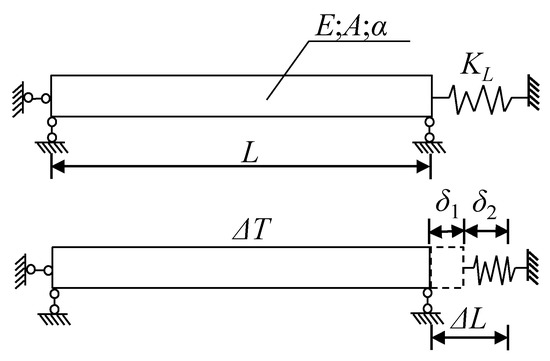
Figure 1.
Schematic diagram of a simply supported beam subjected to temperature.
2.2. Temperature Strain Measurement Based on Vibrating Wire Strain Sensor
The embedded vibrating wire strain sensor is mainly composed of two tension and compression sheets, protective sleeves, steel strings, thermistors, coils and cables. Thermistors are used to measure temperature data synchronously. The embedded vibrating wire strain sensor is embedded in the concrete to coordinate the deformation with the structure. The deformation is transferred to the steel string through two tension and compression sheets, and the deformation is transformed into the stress change of the steel string, thus changing the vibration frequency of the steel string. The electromagnetic coil excites the steel string and measures its vibration frequency. The frequency signal is transmitted to the reading device through the cable, and the strain inside the structure can be measured.
Figure 2 is the measurement principle of the strain sensor. When there is no external force in the initial state, the steel string vibrates with stable amplitude according to the initial stress. The working state conforms to the condition of soft and undamped micro vibration. The vibration frequency can be determined by the following formula:
In the formula, f0 is the initial frequency (Hz); L0 is the initial effective length of steel string (mm); is the density of the steel string; and is the initial stress of the steel string.
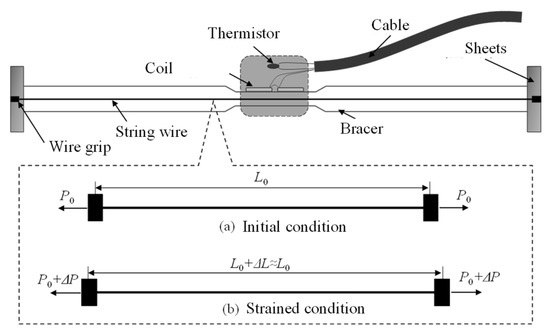
Figure 2.
Schematic diagram of embedded vibrating wire strain sensor.
When an external force is applied, the strain sensor is stretched or compressed accordingly. The stress of the steel string increases or decreases, and the initial frequency also increases or decreases to f. Because the change of the length of the steel string is a minor change compared with its own length, then .
Because the mass m, length L0, cross-sectional area and elastic modulus of the steel string can be regarded as constants, the relationship between the stress of the steel string and the output frequency can be regarded as:
The strain increment of the steel string is:
The vibrating string strain sensor takes the frequency modulus as a strain output signal. The frequency modulus is . By combining Formulas (4) and (9), it can be further obtained that the strain value of the structure under temperature change can be obtained by the following formula:
In the formula, G is the instrument standard coefficient, and the unit is με/Digit (); is the temperature correction coefficient; and T0 and T1 are the initial temperature and current temperature, respectively [17].
3. Engineering Example
3.1. Engineering Background Introduction
A large earthquake engineering simulation research facility project in Tianjin includes a large shaking table and an underwater shaking table. The mass concrete floor of the underground foundation of the underwater shaking table is shown in Figure 3. 1–5 are the position of sensors on middle section, and 6–10 are the position of sensors on edge section. Its pouring size is 81 m × 41 m × 5 m, the local thickness is 4 m, and the total amount of pouring concrete is 16,000 m3. The total pouring time is 60 h. The concrete mix proportion is shown in Table 2.
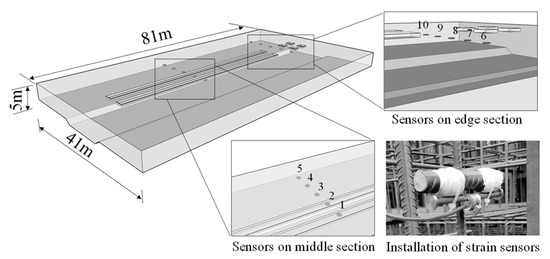
Figure 3.
The size of the concrete plate and the installation position of the strain sensor.

Table 2.
Mix proportion of concrete.
3.2. Engineering Background Introduction
The underground foundation mass concrete floor volume is very large. To meet the structural integrity, a one-time completed seamless pouring construction scheme was adopted. To ensure the safety of the concrete structure during the construction process and after completion, five monitoring points were evenly set from the center to the side on the middle cross-section and the edge cross-section of the concrete foundation slab. The longitudinal sections were arranged in the middle of the structure thickness position (2.5 m from the bottom). Each monitoring point was buried with a BGK4200 vibrating wire sensor that can simultaneously monitor the strain and temperature. In addition, an additional measuring point near the center was arranged as a backup. The sensor placement is shown in Figure 3. The sensor circuit was debugged before the concrete is poured. The acquisition interval was set to 30 min. The internal strain and temperature changes from pouring were continuously monitored by means of automatic acquisition and wireless transmission.
4. Final Setting Judgment Based on Strain Monitoring
4.1. Changes of Early Strain
Strain sensors can reflect the change of concrete from a plastic flow state to the final setting state from the beginning of embedding to the process of synchronous deformation with concrete. Therefore, it is necessary to analyze the early monitoring data to better understand the concrete condensation process. Vibrating string strain sensors use the relationship between the vibration frequency and the strain to reflect the strain condition by measuring the vibration frequency change of steel string under stress. Taking two and eight measuring points as examples, the initial frequency modulus and temperature reading of the strain from pouring are shown in Figure 4.
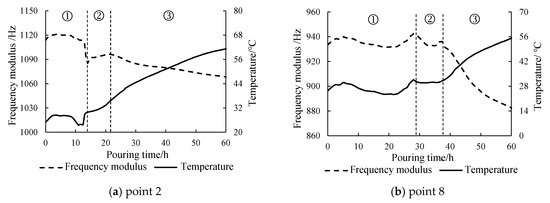
Figure 4.
Early data of measuring.
As shown in Figure 4, the initial reading of the strain sensor from the beginning to the end of the pouring has obviously regular changes. According to the fluctuation trend and the mutation position, the data can be divided into the following three stages. The three stages are represented by ①②③ in the figure.
The first stage (0~13 h of point 2, 0~29 h of point 8):
In this stage, the temperature data of the sensor fluctuates up and down according to the sine curve, which is consistent with the fluctuation trend of the environmental temperature. The strain frequency modulus and temperature show the same change trend, indicating that the sensor has not been covered by concrete during this period. The temperature reading of the strain sensor is the environmental temperature. Currently, the frequency reading of the strain sensor only contains the thermal expansion and cold contraction deformation of the steel string itself due to the change of the environmental temperature.
The second stage (13~21 h of point 2, 29~38 h of point 8):
At the beginning of this stage, the temperature and frequency modulus change abruptly, and the temperature after the abrupt change is about 30 °C, the concrete molding temperature. This indicates that the strain sensor begins to be buried in the concrete at this time. At this stage, the concrete is in a plastic flow state, and the material properties, such as the elastic modulus and the thermal expansion coefficient, change dramatically. At this time, the elastic modulus of the concrete is less than the elastic modulus of the strain sensor, the thermal expansion coefficient is greater than the thermal expansion coefficient of the strain sensor, the strain sensor is not completely constrained, and the steel string is affected by its own temperature deformation and partial structural deformation. The frequency modulus change fluctuates, and the overall trend is consistent with the temperature change trend. At this time, the strain sensor still cannot reflect the true strain of the structure.
The third stage (21~60 h of point 2, 38~60 h of point 8):
After the strain sensor is embedded in the concrete for a period, the concrete condenses and releases a large amount of hydration heat, and the temperature of the strain sensor begins to increase rapidly. At the same time, the frequency modulus corresponding to the strain enters a stable change and decreases with the increase of temperature. At this time, the concrete is restrained by the temperature rise expansion to produce compressive strain, so the frequency modulus decreases, indicating that the strain sensor has been embedded in the concrete to synchronize with its deformation and reflect the real strain. It can then be judged that the concrete reaches the final setting.
4.2. Correlation Analysis of Strain and Temperature Based on Robust Regression
According to Section 2, the early strain response of the structure mainly depends on its temperature effect. To understand the correlation more fully between the strain and temperature data in each early stage and further reflect the process of concrete condensation, a linear regression model is established for strain frequency modulus and temperature data.
Traditional least squares regression aims at minimizing the sum of squared errors. Outliers will have a greater impact on its regression model. The robust regression method applies the robust estimation method to the regression model. The main idea is to modify the objective function in the classical least squares regression, which is very sensitive to outliers, to identify potential outliers, strong influential points, or structures that deviate from the model assumptions. In this paper, robust regression is used to fit the correlation between the strain and temperature.
Through the analysis of Section 3.1, the early sensor data can be divided into three stages. Taking the temperature as the independent variable and the frequency modulus reading of the strain sensor as the response variable, a robust regression fitting analysis is performed on the early data of 0–60 h from pouring to completion. Let
In the formula, a and b are undetermined coefficients; T is temperature; and F is the frequency modulus corresponding to the strain. According to the definition of the Pearson correlation measure, the correlation coefficient between the temperature T and the strain sensor frequency modulus F is determined by:
In the formula, is the temperature at each measurement time; is the frequency modulus of the strain sensor at the corresponding time; and and are mean values of the temperature and frequency modulus. The absolute value of R represents the degree of linear correlation between T and F. The closer the value is to 1, the stronger the correlation degree is. The closer the value is to 0, the weaker the correlation degree is. The positive and negative of R indicates positive or negative correlation.
Taking three and eight measuring points as examples, the method above is used to carry out robust regression fitting analysis on the early data from pouring to completion. The fitting results are shown in Figure 5. The correlation coefficient R is extracted and listed in Table 2. The correlation between the temperature and the strain response changes with time from 0 to 60 h.
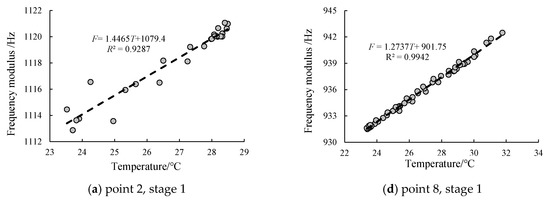
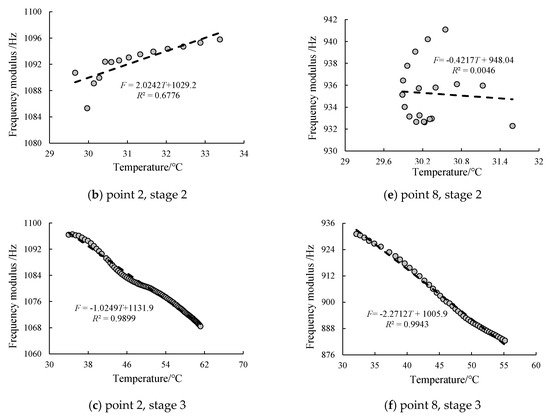
Figure 5.
Correlation between temperature and strain.
The first stage: The sensor is not embedded in the concrete, so the temperature reading of the strain sensor is the ambient temperature. The frequency modulus changes due to the thermal expansion and contraction of the steel string itself affected by the ambient temperature. There is a high linear positive correlation between the two parameters.
The second stage: After the sensor is buried for some time, the concrete is in a plastic flow state. The strain gauges are not fully constrained. The correlation is weakened by other factors, such as concrete flow.
The third stage: The frequency modulus decreases with increasing temperature, showing a strong linear negative correlation between the two. It indicates that the strain gauge has been solidified into the concrete. Then the compressive strain caused by the rising temperature can be read. The concrete reaches the final setting currently, which is consistent with the temperature effect of early strain monitoring.
5. Safety Evaluation
5.1. Selection of the Effective Strain Starting Point
The selection of the effective strain starting point is very important for subsequent strain analysis. Because the deformation after the final setting is the effective deformation, the final setting time can be judged as the monitoring zero point to transform and analyze the initial strain. The initial frequency modulus of each measuring point is shown in Figure 6.
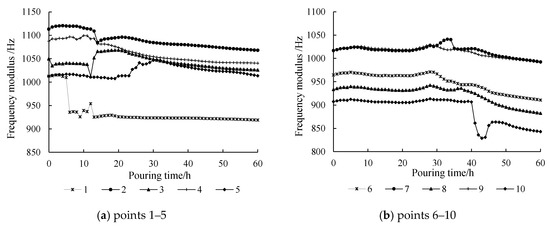
Figure 6.
Frequency modulus of measuring points.
The mass concrete base plate adopts the slope layered pouring method, and the central section position is poured before the edge section. Therefore, points 1–5 are buried earlier than points 6–10 and reach the final setting earlier. Data trends in Figure 6 reflect the actual pouring sequence. In addition, measuring points on the same axis also have a pouring sequence. Among them, measuring point 1 is first buried in the concrete, and the position is also the earliest to reach the final state. The structural thickness of measuring points 5 and 10 t is 4 m, but the height of each measuring point from the bottom surface is 2.5 m. Therefore, the position of measuring points 5 and 10 is significantly higher than that of the other measuring points, and the sensor is buried later and reaches the final setting later. The pouring time and final setting time of measuring points 6–9 is relatively close. The time from pouring until they are buried in concrete is 28–30 h, and the time to reach the final state is 37–40 h. The change process of the initial strain frequency modulus of each measuring point is consistent with the actual pouring sequence. The buried time and final setting time of each measuring point are shown in Table 3. The final setting here refers to the final setting of the location or area where the sensor is buried, and the pouring of the mass concrete floor is still not finished.

Table 3.
Correlation coefficient of temperature and strain.
5.2. Safety Evaluation Based on Reset Monitoring Starting Point Data
According to the conclusion obtained in Section 5.1, the final setting time is taken as the starting point of effective deformation of each measuring point, and the strain conversion is carried out by Formula (10). The strain of each point is shown in Figure 7.
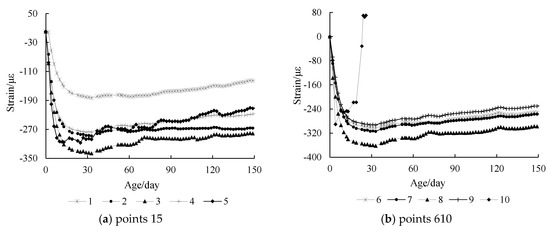
Figure 7.
Strain change of measuring points.
From Figure 7, the compressive strain of each measuring point increases rapidly after pouring, reaches a peak within one month, and then gradually decreases. This is because the concrete is about 1 month old from the beginning of early pouring to the end of hydration heat release. During this period, a large amount of hydration heat is released by cement hydration, and the temperature rise expansion of the concrete is restrained to produce a large compressive strain. The peak range of the compressive strain at measuring points 1–5 is 182.47 με~335.98 με. The peak range of the compressive strain at measuring points 6–10 is 182.47 με~335.98 με. As the temperature gradually decreases, the heat release rate accelerates. Under the combined action of self-heat release and environmental temperature in the middle and late stages, the concrete cools and shrinks, and the compressive strain continues to decrease.
In general, the strain of the central section is smaller than that of the edge position. The pressure changes of measuring points 5 and 10 near the outside reaches the peak earlier, and the subsequent strain decline rate is significantly higher than that of the other measuring points. This is because the external measuring point is more susceptible to environmental impact and releases heat faster, and its temperature deformation is more intense. This is in line with the general conclusion that the surface position has a higher risk of cracking. The compressive strain of measuring point 10 decreases rapidly after reaching the peak value, and the tensile strain appears in a short period of time and increases rapidly. The cause may be a sensor failure or there is a risk of cracking at this location. At this time, the surface cracks should be checked timely.
6. Conclusions
This paper puts forward a method of judging the final setting time of mass concrete based on strain monitoring and the selection criterion of monitoring the zero point, and further carries out structural safety evaluation. Based on the actual project, combined with theoretical and measured data analysis, this paper draws the following main conclusions:
- (1)
- The relationship between strain and temperature during the setting process of mass concrete is proposed. The early strain of mass concrete mainly depends on the temperature effect. There is a clear linear relationship between the strain response and temperature, and a high negative correlation between strain and temperature after final setting.
- (2)
- A method for judging the final setting time of mass concrete based on strain monitoring is proposed: the time point when the frequency modulus corresponding to the strain enters a steady change and decreases with the increase of temperature is taken as the final setting time, which conforms to the concrete condensation mechanism and the temperature effect of early strain monitoring.
- (3)
- The change rule of strain gauge in the condensation process of mass concrete is summarized, and the safety assessment method is put forward: during a period of time after pouring, the strain gauge pressure at each measuring point increases first and then decreases gradually. When the strain data of a measuring point is abnormal, it is necessary to consider whether the concrete at this point has the risk of cracking.
Author Contributions
Conceptualization, J.X. and Z.L.; methodology, C.L. and Z.L.; investigation, C.L. and Z.L.; writing—original draft preparation, C.L. and Z.L.; writing—review and editing, J.X. and Q.M.; supervision, J.X. All authors have read and agreed to the published version of the manuscript.
Funding
This research was funded by National Natural Science Foundation of China, grant number 51408408.
Institutional Review Board Statement
Not applicable.
Informed Consent Statement
Not applicable.
Data Availability Statement
Not applicable.
Conflicts of Interest
The authors declare no conflict of interest. The funders had no role in the design of the study; in the collection, analyses or interpretation of data; in the writing of the manuscript, or in the decision to publish the results.
References
- GB/T 500496; Standard for Construction of Mass Concrete. Chinese Standard Publishing: Beijing, China, 2018.
- Taheri, S. A review on five key sensors for monitoring of concrete structures. Constr. Build. Mater. 2019, 204, 492–509. [Google Scholar] [CrossRef]
- Aydin, A.C.; Gül, R. Influence of volcanic originated natural materials as additives on the setting time and some mechanical properties of concrete. Constr. Build. Mater. 2007, 21, 1277–1281. [Google Scholar] [CrossRef]
- Ahmadi, B.H. Initial and final setting time of concrete in hot weather. Mater. Struct. 2000, 33, 511–514. [Google Scholar] [CrossRef]
- McKenna, C.F. Hardness of Plasters and Cements, and a Simple Chronographic Apparatus for Recording Set. J. Ind. Eng. Chem. 1912, 4, 110–114. [Google Scholar] [CrossRef]
- Amziane, S. Setting time determination of cementitious materials based on measurements of the hydraulic pressure variations. Cem. Concr. Res. 2006, 36, 295–304. [Google Scholar] [CrossRef]
- Trtnik, G.; Valič, M.I.; Turk, G. Measurement of setting process of cement pastes using non-destructive ultrasonic shear wave reflection technique. NDT E Int. 2013, 56, 65–75. [Google Scholar] [CrossRef]
- Hou., W.D.; Zhang, J.; Sun, W. Determination of concrete setting time based on measurements of deformation. J. Chin. Ceram. Soc. 2009, 37, 1079–1084+1091. [Google Scholar] [CrossRef]
- Bhalla, N.; Sharma, S.; Sharma, S.; Siddique, R. Monitoringearly-age setting of silica fume concrete using wave propagation techniques. Constr. Build. Mater. 2018, 162, 802–815. [Google Scholar] [CrossRef]
- Robeyst, N.; Grosse, C.U.; De Belie, N. Measuring the change in ultrasonic p-wave energy transmitted in fresh mortar with additives to monitor the setting. Cem. Concr. Res. 2009, 39, 868–875. [Google Scholar] [CrossRef]
- González-López, G.; Blanch, S.; Romeu, J.; Jofre, L. Debye Frequency-Extended Waveguide Permittivity Extraction for High Complex Permittivity Materials: Concrete Setting Process Characterization. IEEE Trans. Instrum. Meas. 2020, 69, 5604–5613. [Google Scholar] [CrossRef]
- Cusson, D.; Hoogeveen, T. An experimental approach for the analysis of early-age behaviour of high-performance concrete structures under restrained shrinkage. Cem. Concr. Res. 2007, 37, 200–209. [Google Scholar] [CrossRef]
- Bentz, D.P.; Snyder, K.A.; Ahmed, A. Anticipating the setting time of high-volume fly ash concretes using electrical measurements-feasibility studies using pastes. J. Mater. Civ. Eng. 2015, 27, 04014129. [Google Scholar] [CrossRef]
- Lin, S.; Zhu, J.; Yi, T.-H.; Shams, S.; Lv, S. Setting Time Measurement of Concrete Mixtures through Monitoring of Shear-Wave Velocity with Shear-Horizontal Waves. J. Mater. Civ. Eng. 2022, 34, 04022210. [Google Scholar] [CrossRef]
- Azenha, M.; Lameiras, R.; Sousa, C.D.; Barros, J. Application of air cooled pipes for reduction of early age cracking risk in a massive RC wall. Eng. Struct. 2014, 62–63, 148–163. [Google Scholar] [CrossRef]
- Han, Q.; Ma, Q.; Xu, J.; Liu, M. Structural health monitoring research under varying temperature condition: A review. J. Civ. Struct. Health Monit. 2021, 11, 149–173. [Google Scholar] [CrossRef]
- Geokon. Model 4200 Series Vibrating Wire Strain Gauges Instruction Manual. Available online: https://www.geokon.com/4000 (accessed on 7 February 2023).
Disclaimer/Publisher’s Note: The statements, opinions and data contained in all publications are solely those of the individual author(s) and contributor(s) and not of MDPI and/or the editor(s). MDPI and/or the editor(s) disclaim responsibility for any injury to people or property resulting from any ideas, methods, instructions or products referred to in the content. |
© 2023 by the authors. Licensee MDPI, Basel, Switzerland. This article is an open access article distributed under the terms and conditions of the Creative Commons Attribution (CC BY) license (https://creativecommons.org/licenses/by/4.0/).